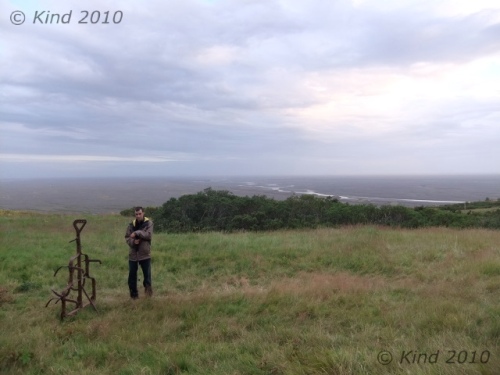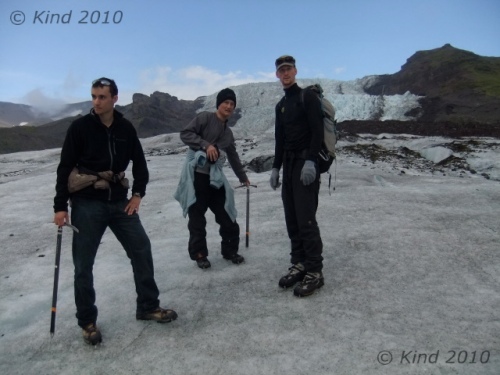On Day Two we prepared our luggage properly, separating actual camping supplies into backpacks, and city supplies into our suitcases. Since I’d packed to leave by essentially hurling things I thought I’d need at my suitcase, this was an important step to take before entering the hiking phase of our trip.

Elf rock
We dropped off our luggage at BSÍ to be stored (in a room choked with the backpacks and suitcases of other travellers) while we spent some more time in Reykjavik for the day. The Free Walking Tour was worth every cent. We learned a number of things on that short walk, from the talkative, bold Icelandic guide who mentioned sex often, told us what he thought of real estate and Icelandic banks, and who had lived nine years in Canada:
The rock in the picture is an elf rock. When machinery breaks or gets stuck when trying to move a rock, they don’t use bigger machinery, they call in a mediator who negotiates with the tenants of the rock for an amicable solution. In this case it was a week to get ready and a new downtown location. I guess hidden people don’t have so much to pack.
 Reykjavik’s city hall houses a wonderful handmade relief map of Iceland. Odd to say, but it really put Iceland in perspective, especially the magnitude of their glaciers. Iceland’s glaciers spit on our “glaciers”. Vatnajökull wouldn’t deign a glance at the Columbia Icefields. Vatnajökull might give PEI a passing nod. Jökull = Glacier. This beautiful piece of work made of 1mm layers of paper took over 16 “man-years” to create- four people over four years. All those complicated little fjörds. I can imagine whoever worked on the Eastfjörds feeling like Slartibartfast from the Hitchhiker’s Guide to the Galaxy– “those fjörds there- I did those.” It is remarkable.
Reykjavik’s city hall houses a wonderful handmade relief map of Iceland. Odd to say, but it really put Iceland in perspective, especially the magnitude of their glaciers. Iceland’s glaciers spit on our “glaciers”. Vatnajökull wouldn’t deign a glance at the Columbia Icefields. Vatnajökull might give PEI a passing nod. Jökull = Glacier. This beautiful piece of work made of 1mm layers of paper took over 16 “man-years” to create- four people over four years. All those complicated little fjörds. I can imagine whoever worked on the Eastfjörds feeling like Slartibartfast from the Hitchhiker’s Guide to the Galaxy– “those fjörds there- I did those.” It is remarkable.
 Inside, Reykjavík’s city hall looks like a place where work gets done, meaning, it’s not pompous at all and doesn’t put on airs. Maybe an air of streamlined efficiency. Outside, it had a striking wall of moss on rock with portholes in it overlooking a square pond.
Inside, Reykjavík’s city hall looks like a place where work gets done, meaning, it’s not pompous at all and doesn’t put on airs. Maybe an air of streamlined efficiency. Outside, it had a striking wall of moss on rock with portholes in it overlooking a square pond.
 We didn’t notice the anchor on a welded chain rising up out of the water. We saw that a week later when we went by and said “Hey! That anchor couldn’t have been sticking out of the water like that when we were here before, we would have noticed!” Are these people fucking with us? The next time we passed city hall, the anchor was sticking out of the water, but at a totally new angle. By that time, we could file it under weird sculpture, which we were quite familiar with, but we still don’t know what’s up with the anchor and why it does what it does.
We didn’t notice the anchor on a welded chain rising up out of the water. We saw that a week later when we went by and said “Hey! That anchor couldn’t have been sticking out of the water like that when we were here before, we would have noticed!” Are these people fucking with us? The next time we passed city hall, the anchor was sticking out of the water, but at a totally new angle. By that time, we could file it under weird sculpture, which we were quite familiar with, but we still don’t know what’s up with the anchor and why it does what it does.
Reykjavik 871 +/-2 is perhaps the world’s most oddly named museum (names of attractions rarely include tolerance factors, I’ve noticed), but it had an awesome elevator. What’s most extraordinary about this place is that an entire, modern, multi-storey building is built over top of an archeological dig, completely preserving the excavation and housing an interpretive museum around it. There’s even a window through the sidewalk looking down into the entrance “lobby” of this hall built in 871 (+/- 2 years – hence the name). They don’t seem to think this is remarkable, and all the pictures and info about discovering the remains of the Settlement Age hall under the foundation of a few other builds, the exceptional effort of preserving it, and the engineering of building around it, all live in an unassuming little room adjacent to the bathrooms. We wouldn’t have seen it except for admiring the elevator.

The elevator!
The exhibit itself is quite interactive with lots of high tech flashy bits. We were already noticing a trend with Icelandic museums: there isn’t a lot of actual stuff in them. Not stuff that’s old, and real. Every single Viking and Settlement artifact known in Iceland could fit in a short wing of the British Museum, if not a room. It was a staggering comparison- the incredible glut of collected historical artifacts jam-packed into every museum we saw when we were in London, versus the starkly empty exhibitions of Iceland (with one exception, that comes later). So, there’s a lot of interpretation going on.
 Museums started to feel like books, written on walls. Like being inside a book. Walk around instead of turn pages. This made me crazy. “I want to be outside, not be in a book!” So we’d dart around museums taking pictures of all the copious text, in two-four languages, for reading later someplace more boring (like Canada) and run back outside. Or not go in the museum at all, once they started to become suspect entities. But this opinion coalesced much later on after more museums. All that my notebook said this day was: I’ic museums don’t seem to take very long to go through. As opposed to say, the British Museum, where you should make sure someone knows when you went in and how long you can live on the snack bars you brought, in case they need to send in a search party a few days later.
Museums started to feel like books, written on walls. Like being inside a book. Walk around instead of turn pages. This made me crazy. “I want to be outside, not be in a book!” So we’d dart around museums taking pictures of all the copious text, in two-four languages, for reading later someplace more boring (like Canada) and run back outside. Or not go in the museum at all, once they started to become suspect entities. But this opinion coalesced much later on after more museums. All that my notebook said this day was: I’ic museums don’t seem to take very long to go through. As opposed to say, the British Museum, where you should make sure someone knows when you went in and how long you can live on the snack bars you brought, in case they need to send in a search party a few days later.
Despite this “lack of old stuff”, Icelanders know their history with a detailed, intimate completeness that’s unrivaled, thanks to the sagas. Caveat to this generalization about Iceland’s museums: we did not take in the National Museum, unfortunately. Possibly there’s a bunch of stuff there. We also missed the Phallological Museum, a members-only  “must-see”.
“must-see”.
Most crucial to our travel plans was the information we could glean about puffins. I was on a mission to see puffins, and we knew our timing was cutting it close, arriving in mid August when the puffins are scheduled to depart.

The Olís cat.
No one seemed to really have their ear to the ground on puffin status in Reykjavik, but consensus seemed to be “you will see puffins still, but they are leaving now.” This solidified our plan for the next couple of days- head for Vestmannaeyjar in pursuit of puffins.
We caught a kid on a two wheeled skateboard and some off-duty blue ninjas practicing in the park on our way to retrieve our packs and get on the road. We got camping gas and ice cream on the way out of town at a gas station that had an interested cat. Cat strolled into the gas station through the automatic door and weaved the aisles like it was looking for something. I shared my ice cream.
 We hitchhiked to Selfoss that night, where we camped among an innundation of German travelers at the campsite. First time with the new tents, and all the research paid off: it rained, and none of our stuff got wet. Success.
We hitchhiked to Selfoss that night, where we camped among an innundation of German travelers at the campsite. First time with the new tents, and all the research paid off: it rained, and none of our stuff got wet. Success.
***** This better not carry on like this – one post per day? I’ll be writing the most comprehensive Iceland travel diary ever- Journey to the Center of Iceland; 20 000 Photos to See (really, really bad pun). Then again…I’ve little else as exciting to write about for awhile.























